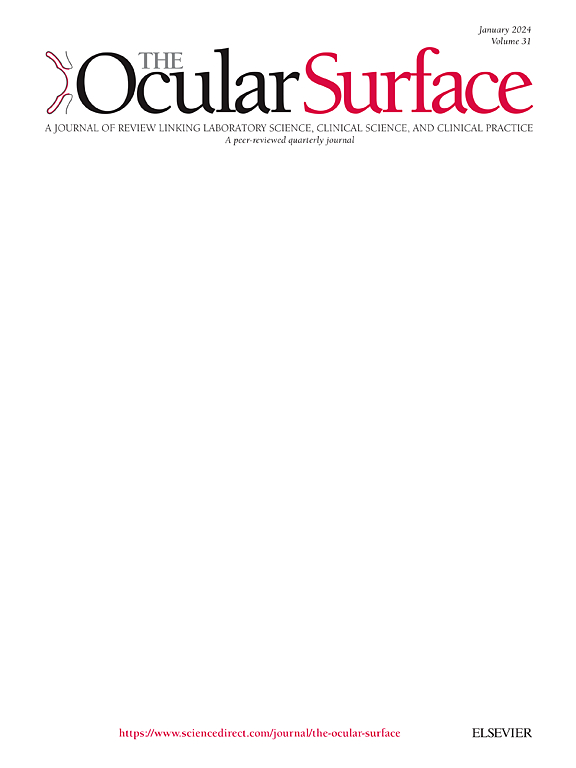干燥应激触发并加剧实验性眼移植物抗宿主病
IF 5.6
1区 医学
Q1 OPHTHALMOLOGY
引用次数: 0
摘要
慢性眼部移植物抗宿主病(oGVHD)是同种异体造血干细胞移植(aHSCT)后最常见的并发症之一。最近的研究表明,移植病房的空调干燥压力增加了oGVHD的发病率。为了验证实验性干燥应激是oGVHD危险因素的假设,我们对oGVHD小鼠模型进行了实验性干燥应激。材料/方法:采用先前建立的化学诱导的oGVHD小鼠小错配模型。其中一组受到干燥压力18天,并与未干燥的GVHD动物进行比较。每周进行临床表型分型,于第7天和第28天采集眼部组织和区域淋巴结进行流式细胞术、泪膜细胞因子分析、角膜淋巴管组织学和树突状细胞计数以及角膜基因表达。结果干燥应激可导致系统性和oGVHD的早期和严重程度,并伴有活化的角膜树突状细胞数量增加,泪膜中TNF表达增加,角膜淋巴管生成提前。基因表达分析提示全身性GVHD严重程度可能影响oGVHD。与非干燥GVHD相比,干燥应激后28天不同的炎症通路上调。结论:上述数据强化了aHSCT期间的干燥应激是oGVHD的危险因素这一假设。加上已经发表的临床数据,越来越多的证据表明,在同种异体造血干细胞移植过程中,保护患者免受干燥。此外,应该开发和测试特定的预防性疗法,以减少oGVHD的发病率和严重程度。本文章由计算机程序翻译,如有差异,请以英文原文为准。
Desiccation stress triggers and exacerbates experimental ocular Graft-versus-host-disease
Introduction
Chronic ocular graft-versus-host disease (oGVHD) is one of the most common complications after allogeneic hematopoietic stem cell transplantation (aHSCT). Recent studies indicate that desiccating stress by air-conditioning in transplantation wards increases the incidence of oGVHD. To test the hypothesis that experimental desiccating stress is a risk factor for oGVHD a mouse model of oGVHD was subjected to experimental desiccating stress.
Materials/Methods: A previously established chemo-induced minor-mismatch mouse model of oGVHD was used. One group was challenged with desiccating stress for 18 days and compared to non-desiccated GVHD animals. Clinical phenotyping was performed weekly and ocular tissue and regional lymph nodes were collected on days 7 and 28 for flow-cytometry, tear film cytokine analysis, histology for corneal lymphatics and dendritic cell counts, and corneal gene expression.
Results
Desiccating stress leads to significant earlier and more severe systemic and oGVHD accompanied by higher numbers of activated corneal dendritic cells, higher expression of TNF in tear film and earlier corneal lymphangiogenesis. Gene expression analysis suggests that systemic GVHD severity may influence oGVHD. Different inflammatory pathways are upregulated at d28 following desiccating stress in contrast to non-desiccated GVHD.
Conclusions
The data presented strengthens the hypothesis, that desiccating stress during aHSCT is a risk factor for oGVHD. Together with already published clinical data, there is increasing evidence that implicates protecting patients from desiccation during the engraftment of allogeneic hematopoietic stem cells. Furthermore, specific prophylactic therapies should be developed and tested to reduce the incidence and severity of oGVHD.
求助全文
通过发布文献求助,成功后即可免费获取论文全文。
去求助
来源期刊

Ocular Surface
医学-眼科学
CiteScore
11.60
自引率
14.10%
发文量
97
审稿时长
39 days
期刊介绍:
The Ocular Surface, a quarterly, a peer-reviewed journal, is an authoritative resource that integrates and interprets major findings in diverse fields related to the ocular surface, including ophthalmology, optometry, genetics, molecular biology, pharmacology, immunology, infectious disease, and epidemiology. Its critical review articles cover the most current knowledge on medical and surgical management of ocular surface pathology, new understandings of ocular surface physiology, the meaning of recent discoveries on how the ocular surface responds to injury and disease, and updates on drug and device development. The journal also publishes select original research reports and articles describing cutting-edge techniques and technology in the field.
Benefits to authors
We also provide many author benefits, such as free PDFs, a liberal copyright policy, special discounts on Elsevier publications and much more. Please click here for more information on our author services.
Please see our Guide for Authors for information on article submission. If you require any further information or help, please visit our Support Center
 求助内容:
求助内容: 应助结果提醒方式:
应助结果提醒方式:


